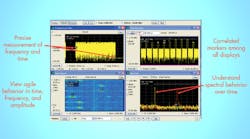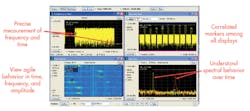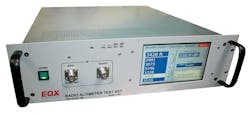This file type includes high resolution graphics and schematics when applicable.
Radar technology has grown in complexity, with a number of advanced techniques now being utilized. For example, complex modulation schemes have found their way into radar applications. These techniques and others have prompted suppliers of test-and-measurement equipment to deliver products to satisfy today’s radar test requirements. With recent innovations in test, as well as simulation, radar is quickly advancing to provide heightened capabilities and advanced features.
Radar Test Solutions
Suppliers of test-and-measurement equipment must provide the tools to satisfy today’s radar test needs. One company that is providing both hardware and software solutions to meet these challenges is Tektronix. “Radar systems designers are turning to techniques such as ever-more complex modulation, pulse compression, and frequency hopping schemes—all of which place significant requirements on the test equipment used to design, test, and characterize these complex systems,” says David Taylor, a technical marketing manager with the firm.
“To meet modern radar and electronic-warfare (EW) test challenges,” Taylor adds, “test solutions must provide simultaneous, multi-domain operation, combining sophisticated signal detection, acquisition, and analysis capabilities in the time, frequency, and modulation domains. Test solutions must also be capable of generating complex high-bandwidth signals so designers can test systems under more realistic conditions.”
Meeting current radar test requirements involves more than just hardware. Software is also counted on to analyze and test today’s radar systems. “Increasingly, modern wideband and frequency hopping radar systems require the use of automated analysis and visualization software solutions,” says Taylor. “With the growing complexity, automated measurement solutions have migrated from being a convenient time-saver to becoming a fundamental requirement for successful radar system design. One example is trend analysis that can involve dozens of pulse parameter measurements on thousands of pulses—it’s simply not feasible to setup and perform these measurements manually.”
Radar designers can take advantage of a variety of tools from Tektronix. “For signal generation needs, our arbitrary waveform generators (AWGs) offer extremely wide modulation bandwidth and deep memory combined with comprehensive waveform generation software,” continues Taylor. “Our spectrum analyzers offer simultaneous multi-domain operation combined with high dynamic range. These are combined with oscilloscope-based solutions with up to 70-GHz bandwidth for capturing the widest RF events. And with the addition of SignalVu software (Fig. 1), we provide a common vector signal analysis (VSA) user interface and feature set across all our instruments.”
Radar Target Simulation
By utilizing a radar target simulator, radar designers and radar system test engineers can create full simulations of moving targets. Such capability is achieved by the new Series 1100 radar target simulator (Fig. 2) from Eastern OptX. The Series 1100 receives a transmitted signal from a radar system and adds the round-trip propagation delay associated with the target distance. Next, that signal is output to the radar receiver. The radar input/output (I/O) can be connected directly to the Series 1100 or, alternately, user-specified antennas can be utilized for receiving and transmitting. For a moving target, the system will add the appropriate Doppler shift associated with the target speed and radar frequency.
“The problem that radar system test engineers have is reproducing targets as they would appear in the real world,” says Joe Mazzochette, general manager at Eastern OptX. “There are a number of ways to create these targets with electronic simulations. However, our approach is to recreate the propagation path that the radar system would see in the real world.
“The test system must be capable of responding very quickly so it can reproduce fast targets with high refresh rates,” Mazzochette adds. “Of course, it has to be accurate. And it has to be capable of accommodating any sort of radar signal format, including pulse, continuous-wave (CW), frequency-agile, and adaptive systems. The Series 1100 test system is a single turnkey box that can be programmed to recreate simulations with very high refresh rates. It can recreate very-high-speed targets (or even very-low-speed targets)—anything from an animal crawling along the ground to the replication of a mortar fire.”
The Series 1100 can cover frequencies as high as 40 GHz while achieving greater than 100 dB of dynamic range. It operates with pulsed, frequency hopping, or CW radars, with any encryption or modulation scheme. Target distances can range from 1 to 100,000 meters. Furthermore, the Series 1100 radar target simulator offers expandable range and operation modes to accommodate new system designs. Applications for these test systems include phased array radar systems, tracking and surveillance, and more.
Design Software for Radar Systems
Designing a radar system can be challenging because it involves the analog, digital, and RF domains. A complete system covers everything from the antenna array to radar signal processing algorithms. As a result, there is a need for modeling and simulation software at different phases of the development cycle.
“Radar technology advancement is one of many trends that we expect will encourage component- and system-level designers to rethink their approach to new product development,” says Ken Karnofsky, senior strategist, signal processing applications at MathWorks. “From a designer’s perspective, radar requires expertise across different engineering areas. These areas include digital signal processing (DSP), RF, and antenna design—a collection of skills that a single engineer rarely possesses. Rather, these complementary talents require underlying modeling, multi-domain simulation, and prototyping tools that provide a commonly understood development platform, in order to enable a clean hand-off at each stage of the design workflow—regardless of the engineer’s specific role.”
MathWorks is fostering radar system design with a collection of tools that includes MATLAB and Simulink, as well as the Phased Array System and Antenna Toolboxes. “Using certain design tools, such as algorithm development software, will help to bridge the technical divide and accelerate the use of simulation and rapid prototyping environments to enable today’s design teams to work more efficiently and effectively,” notes Karnofsky. “Companies like MathWorks must match these rising expectations placed on engineering teams with well-integrated design tools. These tools must enable rapid, efficient prototyping, and yield code that can then be implemented at both the conceptual and production phases of product design.”
To summarize, it is clear that radar technology has significantly increased in complexity. In response, companies are providing cutting-edge design and test solutions to meet these advanced demands. Expect to see suppliers of design and test products continue to rise to the occasion to meet the needs of current and future radar technology.
Looking for parts? Go to SourceESB.
This file type includes high resolution graphics and schematics when applicable.



